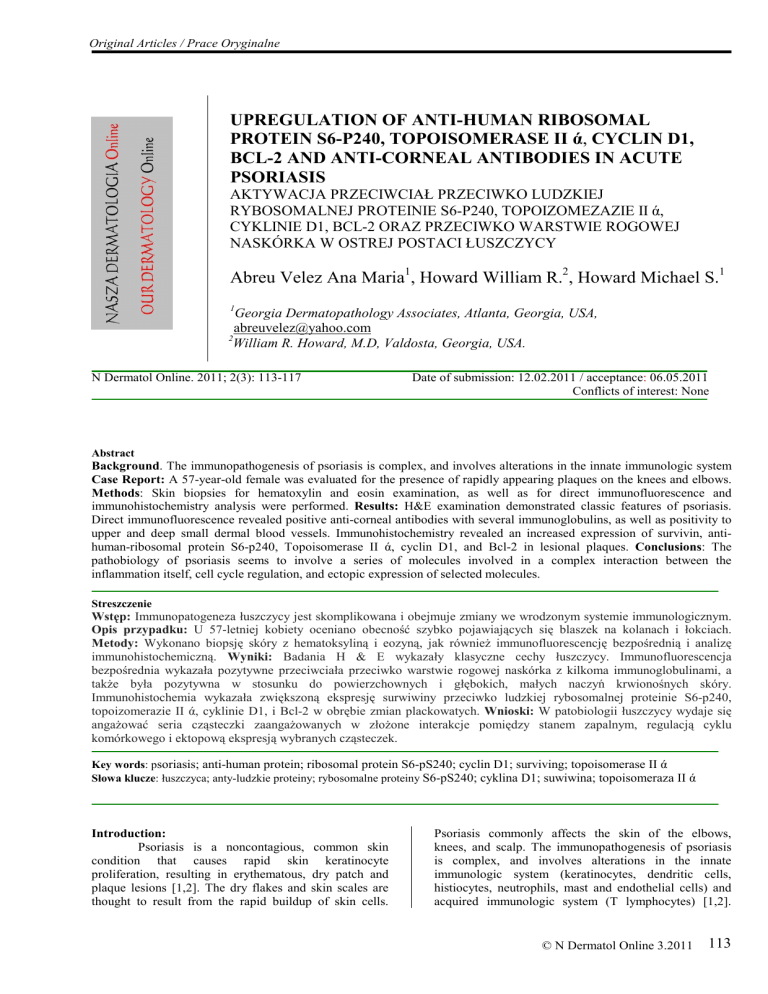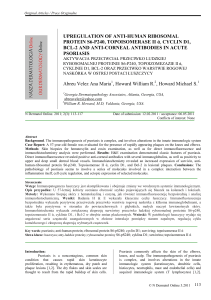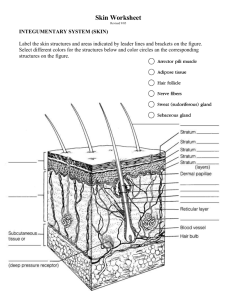Upregulation of anti-human ribosomal topo BCL2 in psoriais
advertisement

Original Articles / Prace Oryginalne UPREGULATION OF ANTI-HUMAN RIBOSOMAL PROTEIN S6-P240, TOPOISOMERASE II ά, CYCLIN D1, BCL-2 AND ANTI-CORNEAL ANTIBODIES IN ACUTE PSORIASIS AKTYWACJA PRZECIWCIAŁ PRZECIWKO LUDZKIEJ RYBOSOMALNEJ PROTEINIE S6-P240, TOPOIZOMEZAZIE II ά, CYKLINIE D1, BCL-2 ORAZ PRZECIWKO WARSTWIE ROGOWEJ NASKÓRKA W OSTREJ POSTACI ŁUSZCZYCY Abreu Velez Ana Maria1, Howard William R.2, Howard Michael S.1 1 Georgia Dermatopathology Associates, Atlanta, Georgia, USA, abreuvelez@yahoo.com 2 William R. Howard, M.D, Valdosta, Georgia, USA. N Dermatol Online. 2011; 2(3): 113-117 Date of submission: 12.02.2011 / acceptance: 06.05.2011 Conflicts of interest: None Abstract Background. The immunopathogenesis of psoriasis is complex, and involves alterations in the innate immunologic system Case Report: A 57-year-old female was evaluated for the presence of rapidly appearing plaques on the knees and elbows. Methods: Skin biopsies for hematoxylin and eosin examination, as well as for direct immunofluorescence and immunohistochemistry analysis were performed. Results: H&E examination demonstrated classic features of psoriasis. Direct immunofluorescence revealed positive anti-corneal antibodies with several immunoglobulins, as well as positivity to upper and deep small dermal blood vessels. Immunohistochemistry revealed an increased expression of survivin, antihuman-ribosomal protein S6-p240, Topoisomerase II ά, cyclin D1, and Bcl-2 in lesional plaques. Conclusions: The pathobiology of psoriasis seems to involve a series of molecules involved in a complex interaction between the inflammation itself, cell cycle regulation, and ectopic expression of selected molecules. Streszczenie Wstęp: Immunopatogeneza łuszczycy jest skomplikowana i obejmuje zmiany we wrodzonym systemie immunologicznym. Opis przypadku: U 57-letniej kobiety oceniano obecność szybko pojawiających się blaszek na kolanach i łokciach. Metody: Wykonano biopsję skóry z hematoksyliną i eozyną, jak równieŜ immunofluorescencję bezpośrednią i analizę immunohistochemiczną. Wyniki: Badania H & E wykazały klasyczne cechy łuszczycy. Immunofluorescencja bezpośrednia wykazała pozytywne przeciwciała przeciwko warstwie rogowej naskórka z kilkoma immunoglobulinami, a takŜe była pozytywna w stosunku do powierzchownych i głębokich, małych naczyń krwionośnych skóry. Immunohistochemia wykazała zwiększoną ekspresję surwiwiny przeciwko ludzkiej rybosomalnej proteinie S6-p240, topoizomerazie II ά, cyklinie D1, i Bcl-2 w obrębie zmian plackowatych. Wnioski: W patobiologii łuszczycy wydaje się angaŜować seria cząsteczki zaangaŜowanych w złoŜone interakcje pomiędzy stanem zapalnym, regulacją cyklu komórkowego i ektopową ekspresją wybranych cząsteczek. Key words: psoriasis; anti-human protein; ribosomal protein S6-pS240; cyclin D1; surviving; topoisomerase II ά Słowa klucze: łuszczyca; anty-ludzkie proteiny; rybosomalne proteiny S6-pS240; cyklina D1; suwiwina; topoisomeraza II ά Introduction: Psoriasis is a noncontagious, common skin condition that causes rapid skin keratinocyte proliferation, resulting in erythematous, dry patch and plaque lesions [1,2]. The dry flakes and skin scales are thought to result from the rapid buildup of skin cells. Psoriasis commonly affects the skin of the elbows, knees, and scalp. The immunopathogenesis of psoriasis is complex, and involves alterations in the innate immunologic system (keratinocytes, dendritic cells, histiocytes, neutrophils, mast and endothelial cells) and acquired immunologic system (T lymphocytes) [1,2]. © N Dermatol Online 3.2011 113 When activated, cells of the innate immunologic system produce growth factors, cytokines and chemokines that act upon the cells of the acquired immunologic system. An inverse relationship also exists, with activated cells of the acquired system acting upon cells of the innate system. Multiple environmental factors, including mechanical trauma, infections, medications and emotional stress may contribute to an outbreak of psoriasis. Case report A 57-year-old female was evaluated for the presence of rapidly appearing plaques on the knees and elbows, with superficial silver scale. A lesional skin biopsy was taken for hematoxylin and eosin (H&E) analysis. In addition, direct immunofluorescence (DIF) and immunohistochemistry (IHC) studies were performed. DIF: In brief, skin cryosections were prepared and incubated with multiple fluorochromes, as previously reported [3,6]. IHC: Performed as previously described3-6. In addition; we utilized anti-human Dako antibodies for HLA-ABC, p53, bcl-2 and membrane attack complex (MAC; complement/C5b-9, myeloma oncogene-1 (MUM1), chromogranin, factor XIIIa, p53 and PNL-2surviving, anti-human ribosomal protein S6-pS240, cyclin D1, Topoisomerase II ά and Ki-67). Results Microscopic description Examination of the tissue sections demonstrates focal, confluent parakeratosis within the epidermal stratum corneum. In addition, scattered collections of neutrophils were present within the stratum corneum; attenuation of the stratum granulosum was noted. Overall, the epidermis displayed mild psoriasiform hyperplasia. Minimal epidermal spongiosis was appreciated. Within the underlying dermis, a mild, superficial, perivascular infiltrate of lymphocytes, histiocytes and neutrophils was observed. No frank vasculitis was present. DIF findings were as follows: IgG (++, focal epidermal stratum corneum); IgA (+, punctuate, discontinuous deposits at the epidermal basement membrane zone (BMZ), and superficial and deep dermal perivascular); IgM (+, focal punctate epidermal stratum spinosum and focal dermal perieccrine); IgD(-); IgE (+, focal epidermal stratum corneum); complement/C1q (-); complement/C3 (+, epidermal stratum corneum and dermal perivascular); complement/C4 (-); Kappa light chains(+, focal epidermal stratum corneum and dermal perivascular); Lambda light chains(+, focal epidermal stratum corneum and dermal perivascular); albumin(-) and fibrinogen (++, focal linear BMZ and superficial and deep dermal perivascular). By IHC, staining for multiple myeloma oncogene-1 (MUM1), chromogranin, factor XIIIa, p53 and PNL-2 were negative. Survivin, anti-humanribosomal protein S6-p240, cyclin D1, bcl-2, antihuman-Topoisomerase II ά, anti-corneal antibodies, and Ki-67 antigen were positive in cells in the areas of the 114 © N Dermatol Online 3.2011 epidermal proliferative changes, as well as surrounding some upper dermal blood vessels (fig. 1,2). Discussion The skin harbors a complex and unique immune system that protects against a complex array of pathogens. Although many of the mechanisms of immune activation in human cutaneous psoriasis have been investigated, many aspects of this process remain to be elucidated. Here we clearly demonstrated reactivity for the anti-corneal antibodies previously described by Beutner et. al., utilizing multiple immunoglobulins [7,9]. In addition, we noted an upregulation of multiple molecules within the epidermis, including positivity to anti-human ribosomal protein S6-p240. The antibody labels human ribosomal protein S6, only when phosphorylated via serine residue 240 (pS240) [10,11]. Human ribosomal protein S6, an approximately 31-kDa protein, is involved in protein synthesis, cell growth and proliferation. Ribosomal protein S6 is phosphorylated on multiple serine residues via the action of p70 S6 kinase [10,12]. Further, phosphorylation of ribosomal protein S6 correlates with increased translation of mRNAs that encode for 1) proteins involved in cell cycle progression and 2) proteins associated with protein synthesis per se, including ribosomal proteins and elongation factors [10,12]. We document an upregulation of anti-human ribosomal protein S6-p240 in psoriasis. In addition, we also detected positive focal expression of anti-human survivin. Survivin represents an inhibitor of an apoptosis repeat motif protein that is principally expressed in G2 and mitosis; survivin has been associated with protection against apoptosis in cells that exit mitosis aberrantly [13,14]. Mammalian survivin has been reported to associate with both centrosomes and the mitotic spindle in apoptosis. The role of survivin in the pathophysiology of psoriasis warrants further clarification. We found also positivity to Cyclin D1. The cyclin protein family is involved the regulation of cell cycle progression. The synthesis of Cyclin D1 is initiated during G1, and drives the G1/S phase transition [14]. Cyclin D1 is one of the major known cyclins, in terms of its functional roles. Cyclin D1 interacts with four Cdks: Cdks 2, 4, 5, and 6. In proliferating cells, the Cyclin D1Cdk4/6 complex accumulation is of great importance for cell cycle progression [14]. The topoisomerase II enzymes control DNA topology by cleaving and rejoining DNA strands, and passing other DNA strands through the process transient gaps.15 The topoisomerase IIα isoform is a 170 kDa nuclear protein, that is only expressed in proliferating cells [15]. Conclusion Psoriasis seems to represent a pathophysiologic product of multiple immune system events, including 1) the production of anti-corneal antibodies, and 2) ectopic, pathologic expression of selected molecules within the upper epidermis. In addition, the disease process appears to include 3) phosphorylation of ribosomal proteins, with resultant increased translation of proteins involved in cell cycle progression, and 4) a directed autoimmune response to these upper epidermal and cell cycle progression molecules. Figure 1. a H & E showing localized hyperparakeratosis in two areas of the epidermal corneal layer (red arrows). b. IHC positivity in some areas of the epidermal stratum corneum and stratum spinosum for anti-human-cytokeratin AE1/AE3 antibody (red/brown staining; red arrows). c IHC positive staining with anti-human kappa light chains antibody within the hyperparakeratotic corneal layer (red/brown staining; red arrows). d. DIF positive staining with FITC conjugated antihuman IgG antibody against the hyperkparakeratotic corneal layer (green staining; red arrows) Note cell nuclei staining positive for 4',6-diamidino-2-phenylindole (Dapi; light blue staining) within the corneal layer, highlighting the pathologic persistence of nuclei in this area. e Positive DIF staining with anti-human kappa light chains antibody within the corneal layer (green staining; red arrow). Please note again the pathologic staining of cell nuclei within the corneal layer with Dapi (light blue staining). We also highlight positive staining with rhodamine conjugated anti-human-IgM (reddish staining; blue arrow). f and g, IHC positive staining in focal parts of the corneal and granular cell layers of the skin with anti-human ribosomal protein S6-pS240 (brown staining; red arrows). h. Positive IHC survivin staining in focal areas of the epidermis and subjacent dermis where the abnormal cell proliferation is occurring (red/brown staining; red arrows). i. Positive IHC staining on individual cells with Cyclin D1 antibody within the epidermal stratum spinosum (brown staining; red arrows). j and k Positive IHC staining for bcl-2 in selected cells of the epidermal basement membrane zone, and in focal, upper dermal perivascular areas (brown staining; red arrows). l. BAX antibody demonstrating weakly positive IHC staining around superficial dermal blood vessels (brown staining; red arrow). © N Dermatol Online 3.2011 115 Figure 2. a through d. Positive IHC staining within small blood vessels with anti-human antibodies to lambda light chains (a and b); and kappa light chains (c and d). Further, note positive staining is demonstrated in subcutaneous adipose tissues in a and d, and within dermal blood vessels in b and c. e. Positive bcl-2 staining around upper dermal blood vessels (brown staining; red arrows). f. Positive PAS staining within dermal blood vessel walls (red/blue staining; red arrows). g. Focal S-100 positive IHC staining in focal areas of the epidermis and dermis (brown staining; red arrows). h. DIF positive staining within the epidermal stratum corneum using FITC conjugated anti-human kappa light chain antibodies (green staining; red arrow). i. Positive DIF staining of FITC conjugated anti-human IgA antibody against deep dermal blood vessels (green staining; red arrows). j and k IHC positive staining against anti-human Topoisomerase II ά in focal upper dermal and epidermal areas(brown staining; red arrows). l. IHC positive staining in focal areas of the epidermal spinous cell layer with anti-human ribosomal protein S6-pS240 (brown staining; red arrows). 116 © N Dermatol Online 3.2011 REFERENCES / PIŚMIENNICTWO: 1. Sanchez AP: Immunopathogenesis of psoriasis. An Bras Dermatol. 2010; 85: 747-749. 2. Lowes MA, Bowcock AM, Krueger JG: Pathogenesis and therapy of psoriasis. Nature. 2007; 445: 866-873. 3. Abreu-Velez AM, Howard MS, Hashimoto T, Grossniklaus HE: Human eyelid meibomian glands and tarsal muscle are recognized by autoantibodies from patients affected by a new variant of endemic pemphigus foliaceus in El-Bagre, Colombia, South America.J Am Acad Dermatol. 2010; 62: 437-447. 4. Abreu Velez AM, Howard MS, Hashimoto T: Palm tissue displaying a polyclonal autoimmune response in patients affected by a new variant of endemic pemphigus foliaceus in Colombia, South America. Eur J Dermatol. 2010; 20: 7471. 5. Howard MS, Yepes MM, Maldonado-Estrada JG, VillaRobles E, Jaramillo A, Botero JH, et al. Broad histopathologic patterns of non-glabrous skin and glabrous skin from patients with a new variant of endemic pemphigus foliaceus-part 1.J Cutan Pathol. 2010; 37: 222230. 6. Abreu-Velez AM, Howard MS, Hashimoto K, Hashimoto T: Autoantibodies to sweat glands detected by different methods in serum and in tissue from patients affected by a new variant of endemic pemphigus foliaceus. Arch Dermatol Res. 2009; 301: 711-718. 7. Qutaishat SS, Kumar V, Beutner EH, Jablonska S: A distinct stratum corneum antigen in psoriasis and its reactions with stratum corneum autoantibodies. APMIS. 1992; 100: 341-46. 8. Jablonska S, Beutner EH: Immunopathology of psoriasis. J Invest Dermatol. 1983; 4: 381-382. 9. Kumar V, Jones P, Beutner EH, Jablonska S: Immunofluorescence studies in psoriasis: detection of antibodies to stratum corneum in psoriatic scales. Ann NY Acad Sci. 1983; 420: 361-368. 10. Ferrari S, Bandi HR, Hofsteenge J, Bussian BM, Thomas G: Mitogen-activated 70K S6 kinase. Identification of in vitro 40 S ribosomal S6 phosphorylation sites. J Biol Chem 1991; 266: 22770-22775. 11. Lekmine F, Sassano A, Uddin S, Smith J, Majchrzak B, Brachmann SM, et al: Interferon-gamma engages the p70 S6 kinase to regulate phosphorylation of the 40S S6 ribosomal protein. Exp Cell Res 2004; 295: 173-182. 12. Volarevic S, Thomas G: Role of S6 phosphorylation and S6 kinase in cell growth. Prog Nucleic AcidRes Mol Biol 2001; 65: 101-127. 13. Li F, Ambrosini G, Chu EY, Plescia J, Tognin S, Marchisio PC, et al: Control of apoptosis and mitotic spindle checkpoint by survivin. Nature. 1998; 396: 580– 584. 14. Bloom J, Cross FR: Multiple levels of cyclin specificity in cell-cycle control. Nat. Rev. Mol. Cell Biol. 2007; 8: 149–160. 15. Woessner RD, Mattern MR, Mirabelli CK, Johnson RK, Drake FH: Proliferation- and cell cycle-dependent differences in expression of the 170 kilodalton and 180 kilodalton forms of topoisomerase II in NIH-3T3 cells. Cell Growth Differ 1991; 2: 209-214. Funding source: Georgia Dermatopathology Associates, Atlanta, Georgia, USA © N Dermatol Online 3.2011 117 Comments to the article UPREGULATION OF ANTI-HUMAN RIBOSOMAL PROTEIN S6-P240, TOPOISOMERASE II ά, CYCLIN D1, BCL-2 AND ANTI-CORNEAL ANTIBODIES IN ACUTE PSORIASIS Abreu Velez Ana Maria, Howard William R., Howard Michael S. Dr. Takashi Hashimoto, Dr. Daisuke Tsuruta PhD, Dr. Takahiro Hamada, Dr. Teruki Dainichi, Dr. Norito Ishii The pathogenesis of psoriasis is complex and includes innate and acquired immunological abnormality and various environmental factors, such as mechanical trauma, infections and emotional stress. However, the real mechanisms in the skin lesion production are still largely unknown. In this study be Dr. Abreu-Verez and her colleagues, the presence of autoantibodies and the altered expression of many epidermal component proteins were examined by direct immunofluorescence and immunohistochemistry, using skin biopsies obtained from active psoriasis skin lesions [1]. Most interestingly, direct immunofluorescence showed multiple immunoglobulin and complement depositions in various areas in the skin; i.e., IgG in the stratum corneum, IgA in the epidermal basement membrane and dermal vessels, IgM in the stratum spinosum and sweat glands, IgE in the stratum corneum, C3 in the stratum corneum and dermal vessels, light chains in the stratum corneum and dermal vessels, and fibrinogen in the basement membrane and dermal vessels. In addition, the authors also performed immunohistochemistry using specific antibodies various epidermal components. In the epidermis of the patient skin, myeloma oncogene-1 (MUM1), chromogranin, factor XIIIa, p53 and PNL-2 were negative, while surviving, S6-p240, cyclin D1, BCL2, topoisomerase II and Ki-67 were positive. The results in this study first confirmed the old finding that psoriasis patients show complement activating autoantibodies to stratum corneum, that was reported by the group of Dr. Beutner [2]. In addition, the results in this study also suggested that psoriasis patients may have antibodies of various classes to stratum spinosum, basement membrane, sweat glands and dermal vessels, although the significance of these findings are not known at the present. Moreover, by immunohistochemistry using specific antibodies, the authors showed that expression of some epidermal components in the psoriatic skin may alter. 118 © N Dermatol Online 3.2011 These changes may contribute to the pathogenesis in pemphigus. CONFLICT OF INTEREST The authors state no conflict of interest. REFERENCES / PIŚMIENNICTWO: 1. Abreu-Verez AM, Howard WR, Howard M): Upregulation of anti-human ribosomal protein S6-P240, topoisomerase II a, cynclin D1, BCL-2 and anti-corneal antibodies in acute psoriasis. N Dermatology Online 2011; 2: 113-117 (this issue) 2. Kumar V, Jones P, Beutner EH, Jablonska S: Immunofluorescence studies in psoriasis. Detection of antibodies to stratum corneum in psoriatic scales. Ann NY Acad Sci 1983. 420:361-368. Department of Dermatology, Kurume University School of Medicine, and Kurume University Institute of Cutaneous Cell Biology, Kurume, Fukuoka, Japan Correspondence: Dr. Takashi Hashimoto, Department of Dermatology, Kurume University School of Medicine, and Kurume University Institute of Cutaneous Cell Biology, 67 Asahimachi, Kurume, Fukuoka 830-0011, Japan. Email: hashmot@med.kurume-u.ac.jp


